On my recent Montana camping trip I was pleased to note that the good folks of Big Sky Country care deeply about their bluebirds. Nest boxes of every description and age seem to be abundant on both private and public land and along road corridors. Nesting season was in full swing, as were the traditional spats between Mountain Bluebirds and Tree Swallows for nesting rights to the boxes.
On these trips I can never resist photographing the bluebirds in particular as they perform their domestic duties. (several of these shots were taken at ISO 1000 so you’ll likely notice a little noise in the background).
1/2000, f/5.6, ISO 800, 500 f/4, 1.4 tc, natural light
Here, a gorgeous male brings breakfast to a nest-full of youngsters. During summer they consume a variety of insects but caterpillars of various species are their preferred prey.
1/3200, f/5.6, ISO 1000, 500 f/4, 1.4 tc, natural light
During incubation and brooding only the male hunts and delivers food to the nest but thereafter both sexes make about equal numbers of feeding trips to the fledglings. Here the female is approaching the nest opening out of frame to the left.
1/2500, f/6.3, ISO 800, 500 f/4, 1.4 tc, natural light
In a different sequence she’s almost there…
1/2500, f/5.6, ISO 800, 500 f/4, 1.4 tc, natural light
and at the last second (in the next frame of the burst) she flares slightly, pulls up her feet to grasp the bottom of the entrance hole and ducks her head to avoid a collision with the overhanging roof.
1/3200, f/5.6, ISO 1000, 500 f/4, 1.4 tc, natural light
Here the male makes his exit from the box after a food delivery. He almost looks happy to get out of there…
1/25000, f/7.1, ISO 500, 500 f/4, 1.4 tc, natural light
In this image a different bluebird (this shot was actually taken in the same area last year) is ground-foraging for a meal. I had no more room to the left in the frame for composition but I still liked the behavior.
These thrushes are energetic and efficient hunters. I found the following quote from BNA Online to be quite the eye-opener: “In its behavioral ecology, (the Mountain Bluebird) resembles not so much a thrush, or even other bluebirds, as it does a scaled-down version of an American Kestrel (Falco sparverius).”
1/2500, f/5.6, ISO 1000, 500 f/4, 1.4 tc, natural light
With that much food going into the nest, waste disposal becomes an obvious issue and both parents remove fecal sacs after feeding trips. Here the male has just exited the nest hole with a beak-full of those sacs.
As a kid growing up on a farm in NW Montana I remember Western Bluebirds being relatively abundant but it’s been years since I’ve seen one up there. That species has mostly disappeared from the valleys of Montana where they were once common due to land-use changes over the years and possibly because of competition from House Sparrows and European Starlings.
For me, the beautiful, bold and charismatic Mountain Bluebird is a worthy substitute (though I still miss the Western Bluebirds).
Ron


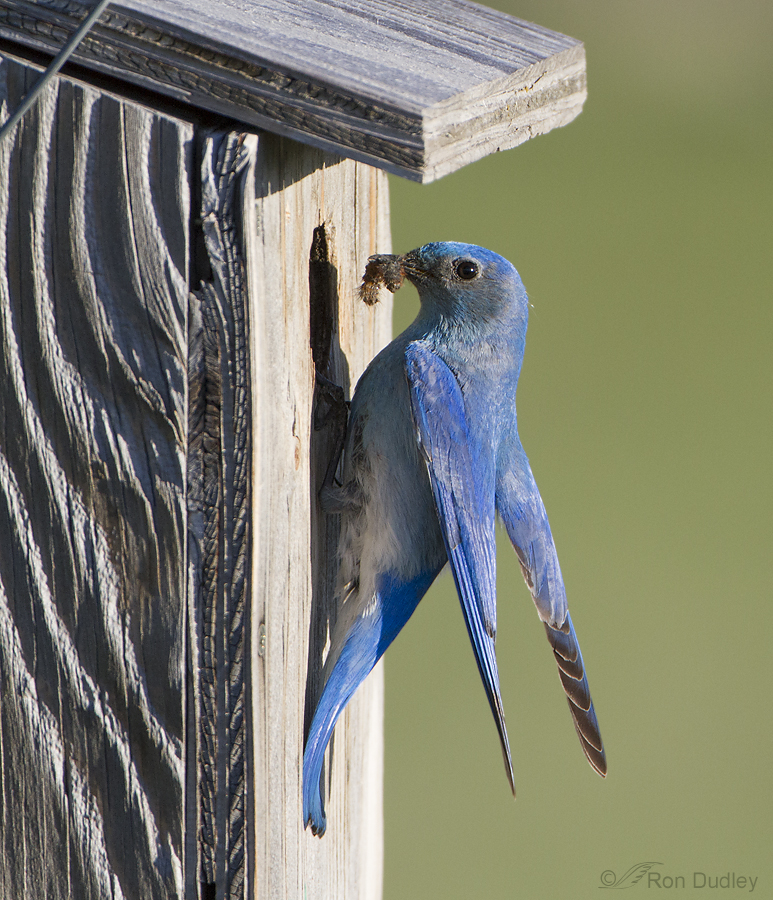
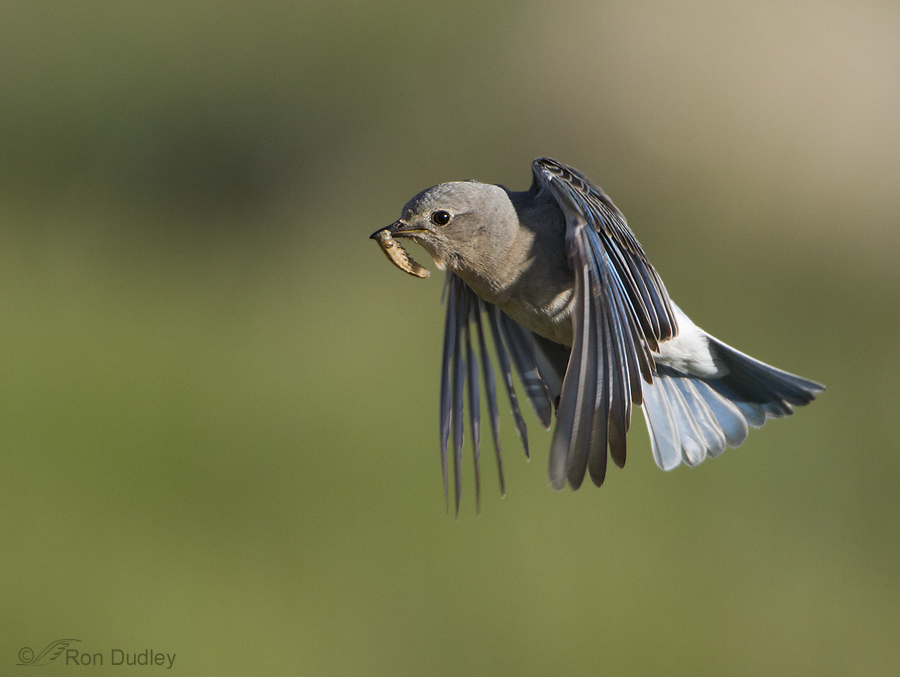
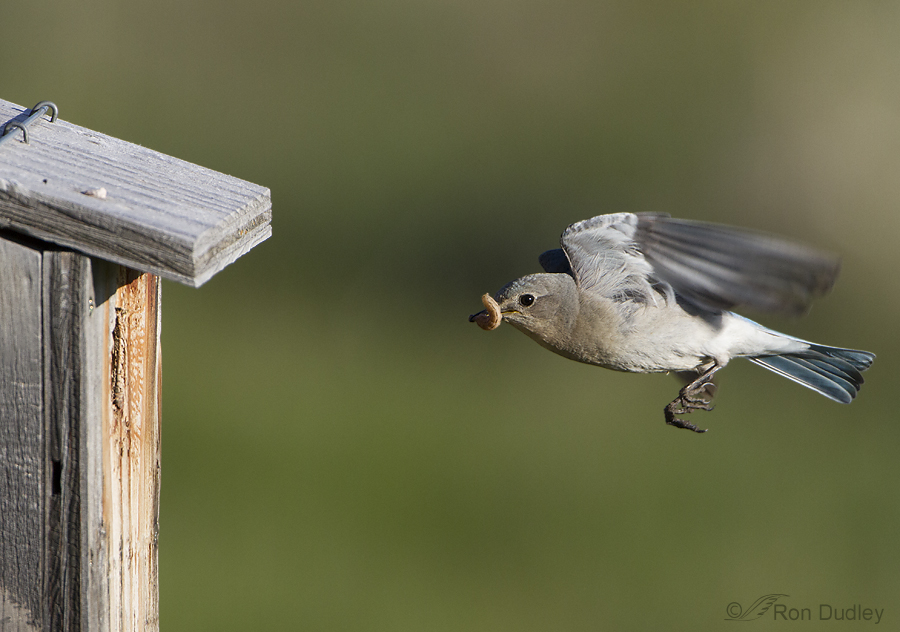
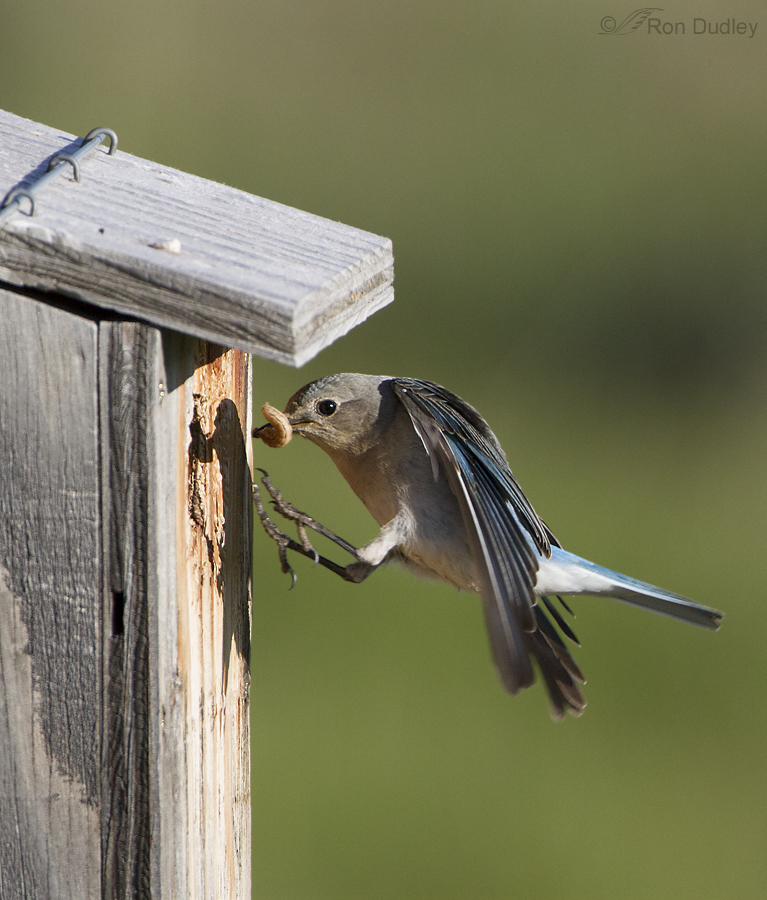
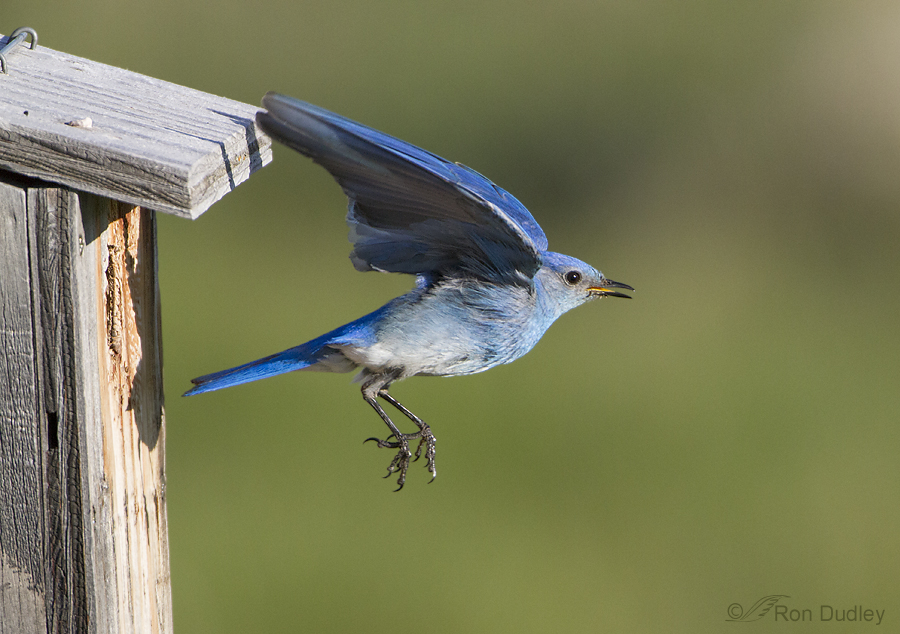
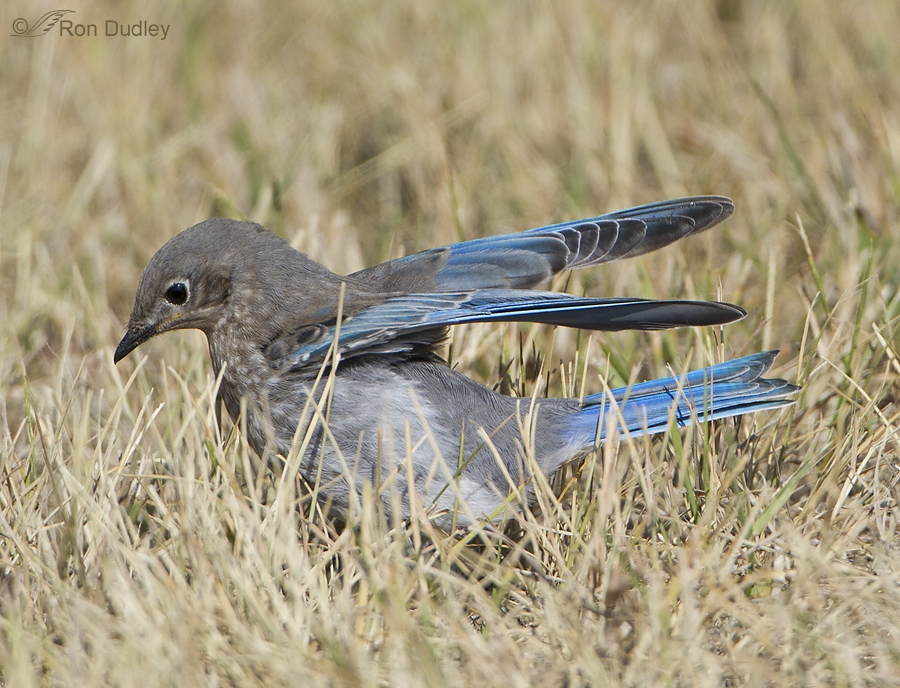
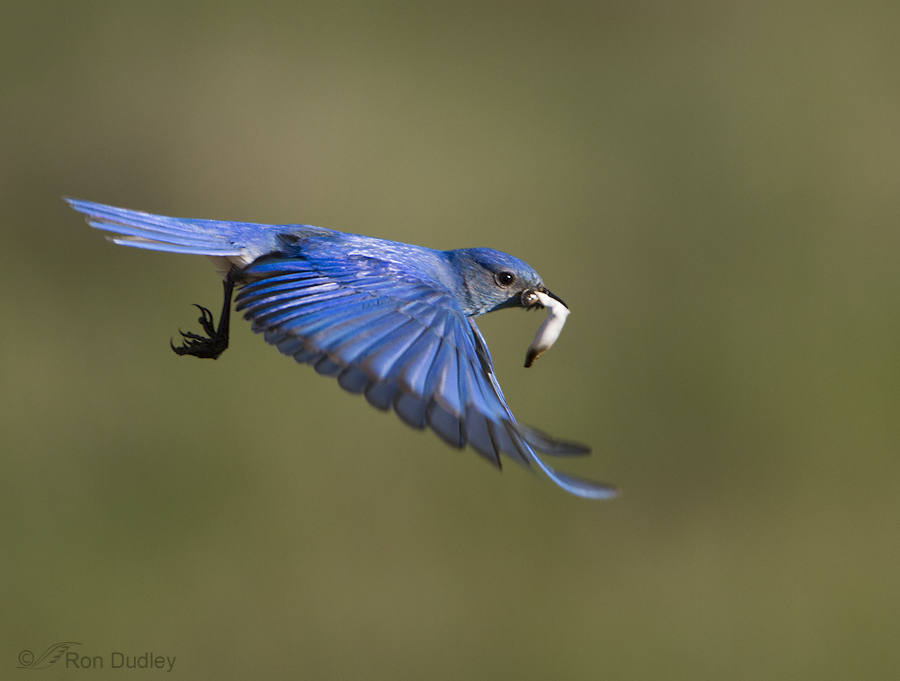
Ron,
What came I say…Wow, love all the in flight shots, you are good!! What camera and lense are ou using?
I dont have a very good camera and have been looking at the Cannon Rebels and a 200 mm lense.
We don’t have the mountain bluebirds, we have the eastern bluebirds since I live in South Carolina, USA. Started a blog and posted a few pictures on my boxes, pictures are not very good but I will be getting me a camera once I figure out these best one for me.
Michael
Bluebirds Eating Live Mealworms
Sensational Ron! Thanks so much!
Charlotte Norton
Beautiful!
Wonderful to see photos of mountain bluebirds. I lived in Richmond, VA for many years and for the first 10 years or so kept a bluebird nest box. I really enjoyed the eastern bluebirds. Looks like all species of bluebirds are special.
I think you’re right, Susan – all bluebird species are special (though I must admit I’ve had no experience with the eastern variety.
I have a busy and somewhat fraught day ahead. I am so glad I made the time to visit you this morning and so very grateful for your images of this beautiful bird, which will brighten all of my day. Thank you.
I don’t like it when you use the “fraught” word to describe your upcoming day, Elephant’s Child. You’ve had too many of them for much too long. I hope it went better than expected, I truly do.
And thank you for the kind words regarding the bluebird images.
Great shots of one of my favorite birds. My bluebird box has Western bluebirds in it this year! Last year it had mt. bluebirds. And another one has house sparrows. Thanks for this lovely sequence.
Tana, It’s been so long since I’ve seen a Western Bluebird! I just might have to come down your way this summer and look for them…
Ron, I am not sure which I like better the photo of the female ducking to enter where you captured her silhouette perfectly on the nest box or the comment that really made me look and see that both behavior and the bill/beak makes me think of the male kestrel I feed here.
And seeing how they clean up the nest box and carry the fecal sac away from the nesting area is amazing.
Again your attention to detail and photos made my day.
Interesting that you mention the silhouette/shadow, Diana. These birds are fast, hard to track and to keep in focus. When I was culling images I actually had several shots where there were no birds in the frame (I simply missed them) but they showed the complete shadow of the incoming bird on the front of the nest box. Now I wish I’d saved them, just for fun…
such a joy to view!!!!
Thanks, Lois!
Yes there is something about that first magical shot in the sequence. Maybe the weathered look on the side of the box matches the pattern and color of the underwing feathers. Just beautiful Ron!
And to think that I almost didn’t include that first shot in this post because there was so much of “the hand of man” in the image – it was actually an afterthought. It’s so valuable to me that you and others let me know which images you prefer – makes me constantly reevaluate my own perspective. Thank you, Nancy (and Dwynn and others).
You’ve done it again. I literally gasped when I saw the first image. Each time I think you’ve topped yourself, you come up with something amazing! We had horses when I was a kid, and Eastern Bluebirds…they used the horse hair, esp. mane and tail, for their nests, A friend, Tom Meyer, has put up and monitored hundreds of Bluebird boxes in and around our county, in NY, most of which were beautifully made and given away by a retired banker named Beresford Proctor. He made, and gifted, over 4.000 boxes! I give the two men a lot of credit for the increased number of these flying jewels that we are lucky enough to see returned today. It shows the difference a few dedicated folks can make. We also see boxes along some of the major highways, two at a time…spaced about 10 feet apart, so that tree swallows, etc. will take one and help keep others of their kind away from the second…hopefully leaving it free for the Bluebirds. We have an old farm house in Maine, surrounded by uncut fields and Bluebird houses. Because we let it grow wild, we have all kinds of birds from wild turkeys to Bluebirds. Our former neighbors did the same, but now we have a new neighbor who has fenced her field as a pasture and may have overloaded it with grazers…makes me sad! We’re also worried about the aquifer which runs below her field.
You’ve had some interesting experiences with bluebirds, Patty. Thanks very much for sharing them!
While all these images are spectacular, the first one is my favorite. The grace displayed by this bird in the positions of the wings and tail is pure beauty. Great job, Ron!
Thanks very much, Dwynn.
OUTSTANDING!! Great shots Ron, love em!
Been a Nest Box Cavity monitor for 11 years, even though most of the time Tree Swallows, Great Crested Flycatchers or Chickadees use the boxes. When I have been lucky enough to have an Eastern Bluebird use one of the boxes it has been an absolute delight. They make a great nest, keep a clean box and are terrific parents. I’m sure Mountain Bluebirds are very similar. Thanks for sharing.
Thanks, Dick. I’ve heard that flickers raise havoc with the boxes too – trying to excavate the hole bigger before they figure out that the box is too small for them to use.
Good for you for monitoring those boxes for so many years!